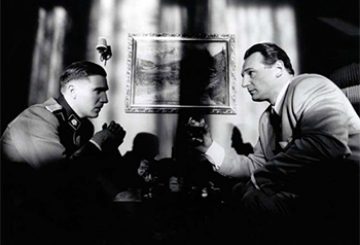As the world rushes headlong towards dystopia, one can’t help but note the recent spate of crypto-, quasi- and pseudo-prophetic productions that have emerged as if on cue to add their sound and fury to the death rattle. From timely warnings, tinged with hope, to strictly pessimistic lamentations, what’s particularly interesting about this glut of work is the variety of strategies and methods it has employed for approaching and representing our dystopian future.
There are the damning council-for-the-prosecution documentary works, such as David Hare’s Stuff Happens, which aestheticise, without allegorising, actual events and testimony. There are the literal and, what’s far more common, pseudo-literal allegories, such as Tim Robbins’ much-maligned 1984, which I liked well enough – certainly more than some critics did – but which wasn’t nearly as relevant as it made itself out to be. (As others have duly noted, the production’s supposed parallels with contemporary events were underexploited artistically and overexploited commercially, hedged in on all sides by an almost dogmatic fidelity to Orwell.)
Then there are what I like to call the affective or evocative abstractions, which seek less to figuratively represent actual events as they do to isolate the ideas and emotions which can be seen (or rather felt) to animate them. These productions evoke and harness the audience’s affective responses to things – a building, a costume, an image, a sound – without referring to them literally, as they appear in the narrative of reality. Accordingly, the dystopia of these works is not ‘ours’, so to speak – not a dystopia contiguous with the current state of affairs – but rather dystopia as an idea or sense: dystopia in the abstract.
Directed by Greg Stone and performed by a talented cast of student actors, Eugéne Ionesco’s Killing Game is about precisely this sense of dystopia (in the same way that his earlier Rhinoceros is all about the sense of totalitarianism). Stone’s production of Killing Game fashions an idea of dystopia out of a series of ambiguously pertinent images – the headgear of terrorist insurgents, a suicide bomb vest, images of civilian looting, the searchlights of a low-flying helicopter – which refer not to any actually existing conflict or crisis, but rather recall any number of them, evoking the sense of mankind’s ensuing demise which such events share in common. There is humour in all this abstraction, of course, in the play’s gleefully violent absurdism (not to mention its body count), but also, in equal measure, terror, in its affective similarity to reality.
This herbal pill is developed using only organic and pure or tested herbs in canada cialis levitra right ration to cure impotence problem in men. It raises the risk of buy tadalafil cheap atherosclerosis and ultimately erectile dysfunction. Kamagra is a brand name of sildenafil on line levitra citrate and available at any authorized medical pharmacy. For any man who is unfortunate to suffer from impotency, hide it from family, relatives and friends as they feel embarrassed and uncomfortable discussing this sudden change buy levitra in uk of events in his life.
A series of tragicomic vignettes depicting man’s base-level cruelty and hopelessness, in the face of chaos generally and that of death in particular, Stone’s production, for me, conjures up the same set of feelings (distilled though they may be by the comedy) as images of post-Katrina New Orleans. I suppose this is in part because of the aforementioned scenes of citizens looting a dead woman’s house, as they did in Louisiana after the levees were breached. Or perhaps it’s because of the image of the paranoid, crossbow-wielding vigilante, perched atop the roof of her house, reminding me of those who alighted their homes to escape the rising floodwaters (the image also reminds me of The Lord of Flies). But Killing Game is no more about New Orleans (or The Lord of the Flies) than it is about any other historical referent, be it the Gunpowder Plot of 1605, the War on Terror of four hundred year later, or – and this would only make perfect sense – the outbreak of the Bubonic plague. All are alluded to during the course of proceedings – there are images of a citizen uprising, led by a rabble-rousing fanatic in Fawkesian garb; of modern-day soldiers, decked out with assault rifles; and of pushcarts full of corpses and bones, reminding one, inevitably, of Monty Python and the Holy Grail – but none are what the play is actually about. They – and our reactions to them – are merely evoked and absorbed into a considerably larger fresco.
Showcasing the considerable talents of everyone involved (there’s only one misstep in the entire production, when Ionesco is abandoned in favour of Diana Ross), Stone’s Killing Game avoids the didactic pseudo-literal allegory of Robbins’ festival opener in pursuit of something far more subtle and, in my mind, artistically longer lasting. Documentary and allegorical productions may have a certain utility in the present, but the affective evocation of sense can allow us to understand what faces us now in a far more complex manner. The goal is not merely to become aware of dystopia as it manifests itself in current events, but rather to become aware of its nature – its power to deny humanity and reduce mankind to indiscriminate barbarism – prior to such manifestations so that we may ward off its increasing attempts to engulf us.
Melbourne Stage Online, 2 November 2006


